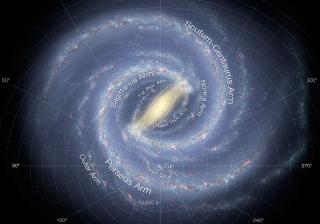Bibcode
Cabrera-Lavers, A.; González-Fernández, C.; Garzón, F.; Hammersley, P. L.; López-Corredoira, M.
Referencia bibliográfica
Astronomy and Astrophysics, Volume 491, Issue 3, 2008, pp.781-787
Fecha de publicación:
12
2008
Revista
Número de citas
96
Número de citas referidas
86
Descripción
Context: Over the past decade there have been a series of results
supporting the hypothesis of the existence of a long thin bar in the
Milky Way with a half-length of 4.5 kpc and a position angle of around
45°. This is apparently a very different structure from the triaxial
bulge of the Galaxy, which is thicker and shorter and dominates the star
counts at |l|<10°. Aims: In this paper, we analyse the
stellar distribution in the inner Galaxy to see if there is clear
evidence for two triaxial or bar-like structures in the Milky Way. Methods: By using the red-clump population as a tracer of Galactic
structure, we determine the apparent morphology of the inner Galaxy.
Deeper and higher spatial-resolution near infrared photometry from the
UKIDSS Galactic plane survey allows us to use in-plane data even at the
innermost Galactic longitudes, a region where the source confusion is a
dominant effect that makes it impossible to use other databases, such as
2MASS or TCS-CAIN. Results: We show that results previously
obtained with the red-clump giants are confirmed with the in-plane data
from UKIDSS GPS. There are two different structures coexisting in the
inner Galactic plane: one with a position angle of 23.6- ° ±
2.19 ° that can be traced from the Galactic centre up to ~10°
(the Galactic bulge), and other with a larger position angle of 42.44
° ± 2.14 °, that ends around l=28° (the long Galactic
bar).
Proyectos relacionados

Morfología y dinámica de la Vía Láctea
El Proyecto se estructura en dos partes, diferenciadas pero complementarias: morfología y dinámica. El estudio detallado de la morfología de la Vía Láctea pretende proveer una base de datos de distribución estelar en las regiones más alejadas y extintas de nuestra Galaxia, mediante el desarrollo de modelos semiempíricos a partir de la información
Martín
López Corredoira

Huellas de la Formación de las Galaxias: Poblaciones estelares, Dinámica y Morfología
Bienvenida a la página web del g rupo de investigación Traces of Galaxy Formation. Somos un grupo de investigación amplio, diverso y muy activo cuyo objetivo principal es entender la formación de galaxias en el Universo de una manera lo más completa posible. Con el estudio detellado de las poblaciones estelares como bandera, estamos constantemente
Anna
Ferré Mateu